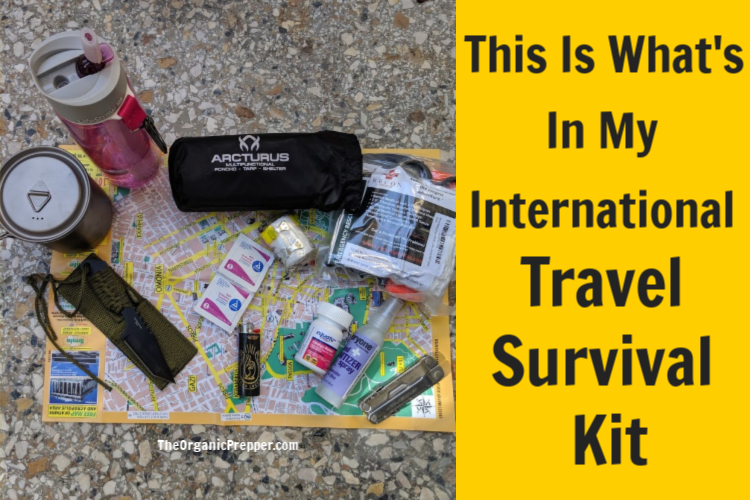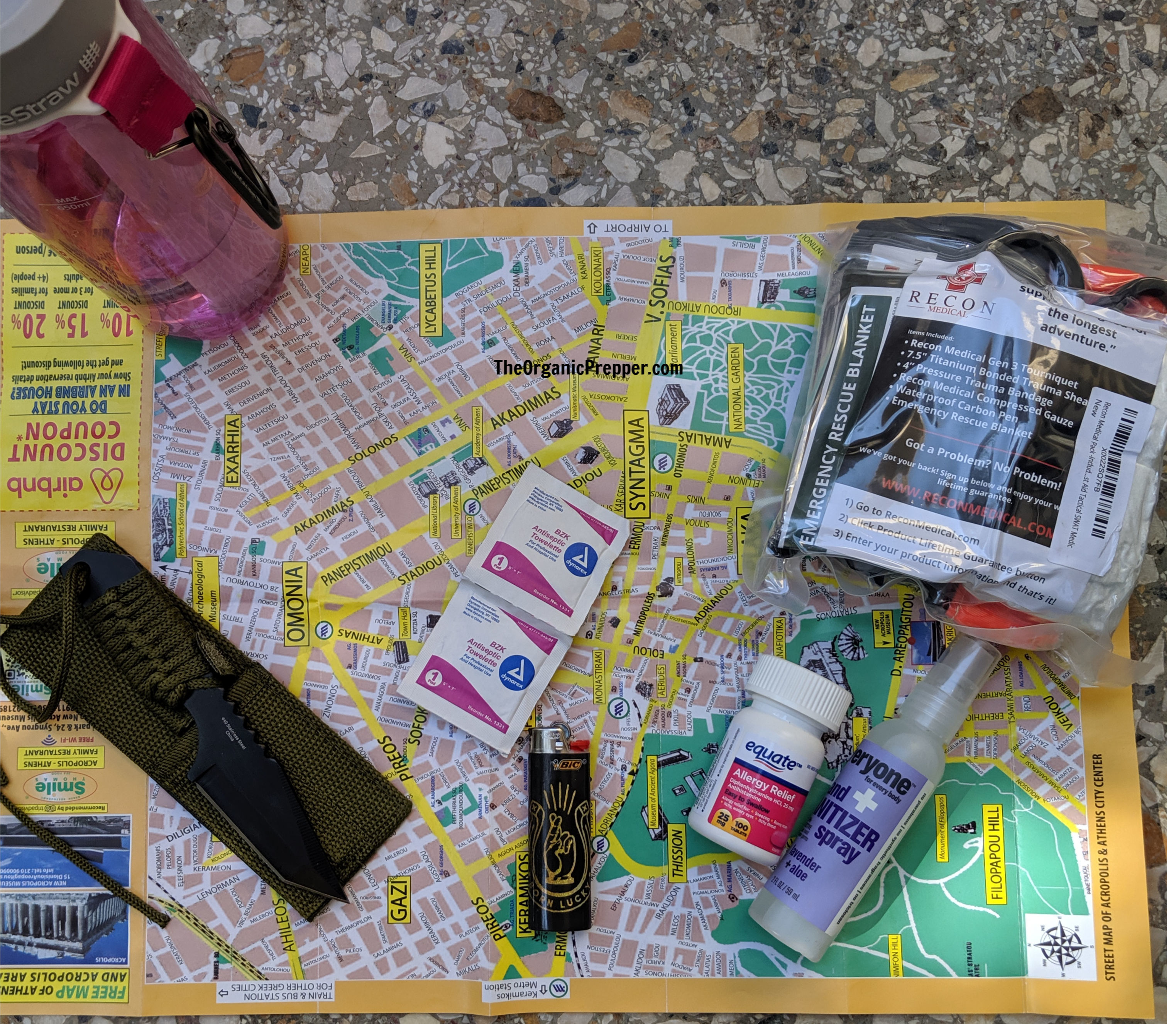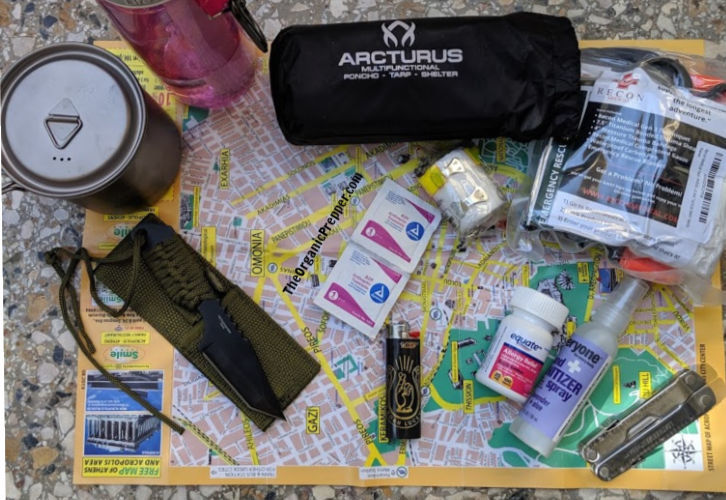If you're new here, you may want to subscribe to my RSS feed. Thanks for visiting!
Author of Be Ready for Anything and Build a Better Pantry on a Budget online course
As I travel through Europe, a lot of folks are asking how I can be prepped. When traveling, your choices should lean more toward survival than prepping. (I wrote about the differences between the two here.) And for that, you need a small amount of extremely versatile gear.
In this article, I’ll share what I brought with me and why. I spoke to some pros like Toby Cowern and Selco while making my final choices and many other choices were based on what I learned in their urban survival course in Croatia. (PSST: Registration for the 2020 Urban Survival Course for Women is now open! Check it out!)
I have an everyday carry kit that easily fits into my purse along with a light jacket. Secondarily, I have a bug-out kit with a few additional items I’d take if I made the decision to evacuate in a hairy situation. We’ll talk about the EDC first, then move on to the bug-out kit.
Note that this does not include all the things that I brought. I have a veritable pharmacy in my suitcase for treating everything from nausea, infections, pain, and the common cold. I have bandaids for blisters and a Kindle for reading and all manner of items. But that’s a topic for another article.
What I carry every day while traveling
Before we get too deeply into this, I strongly advise you to understand the laws and restrictions in the country you’re visiting. Women can often get away with a little more than men when it comes to sharp, pointy things, but if I was in England where the laws about knives are extremely strict, for example, I wouldn’t risk carrying a knife around beyond a small folding knife, if even that.
Here’s my EDC kit in all its ordinary glory.
These things all fit comfortably in my purse, which is this crossbody bag that has RFID-blocking protection. Not fancy but it gets the job done. This stuff is Layer 1 according to Selco.
Let’s go through what I’ve got.
- I always grab a paper map as soon as possible upon my arrival. You can get these free at tourist welcome centers and sometimes at the airport. Google Maps is great if you have data, but it isn’t infallible, and there’s always a possibility you may have a dead battery or no service when you need it. Paper maps always work. For privacy reasons, this is not my marked copy. I put a dot with a sharpie on important places like the American Embassy, my rental, the police stations, and the hospital. Any place I might need to go in an emergency gets a symbol like a cross for the hospital, a star for the PD, and different shapes for different locations. This code is memorized.
- Hand sanitizer. It’s not just good for cleaning your hands. You can use it to add some fuel if you are starting a fire – hand sanitizer that contains alcohol burns like crazy.
- Benadryl. I have food allergies so I always keep a bottle of Benadryl on me, especially when I’m traveling and may not be able to explain clearly what ingredients I’m allergic to. My allergies are uncomfortable, but not life-threatening. If you have life-threatening allergies, you’d want to upgrade this to an epi-pen.
- Lighter. That one’s obvious. I did see a pretty interesting self-defense video using a lighter – find it here. Keep your lighter in an outside pocket of your bag or in your pocket so you can get to it easily.
- Knife. This is a smaller, inexpensive fixed blade that I got here from Amazon. I would not travel with one of my more expensive knives because there’s always the possibility of getting it taken away by airport security or the local authorities. I sharpened this one up and really like it, however. The firestriker it comes with is decent, but not excellent, quality. I have used this knife in the kitchen, outdoors, and just to open packages. I carry it discreetly in my purse. If you were carrying it on your person, my advice is: a) don’t be obvious and b) get one with a hard case so you don’t stab yourself if you fall or get knocked down.
- Alcohol wipes. They’re teeny tiny, don’t even weigh an ounce, and can be used for first aid, fire-starting, or cleaning something that urgently needs to be sanitary.
- Lifestraw bottle. I do have other water filters with me – both a Sawyer Mini and a regular Lifestraw – but this is great for everyday use. First of all, a pink water bottle doesn’t scream “tactical nutbar” – it is perfectly normal for people to carry water bottles around to save money and the environment. Find this bottle here in all sorts of colors. With this, I can fill up from a water fountain or tap without worrying about water quality. Or, if it came down to it, I could fill up from a puddle or a source like a stream or a fountain. This can fit inside my purse or be clipped to a belt loop with a carabiner.
- Medical kit. I bought a couple of these trauma medical kits – one to open to make sure the quality was decent and one to leave shrinkwrapped to save space. It contains a pair of shears (good but not great) a tourniquet, a compression bandage (also known as an Israeli bandage), compressed gauze, and a carbon pencil (for marking swelling). This is specifically for a time when you might need to stop heavy bleeding. This is a lot of stuff in a compressed package you can get here for less than $30 and I think it’s a very worthwhile addition.
Not shown:
- Flashlight. I have a small LED flashlight on my keychain.
- Compass. This is more helpful than you realize when making your way around a new city. It can help you orient your map and get to where you’re going. I keep mine in an outer purse pocket because I use it often.
Before I head out I always throw a snack of some sort in my purse, like trail mix, chocolate covered nuts, or peanut butter and crackers. Remember, this kit is not intended to get you through Armageddon. It’s intended to help you deal with a wide variety of urgent emergencies.
If you make your EDC kit too big, you risk making it so heavy and unwieldy that you just leave it at home half the time.
The more extended kit
I wrote yesterday that in a bad situation, Plans A-D are always to get the heck out. My more extended kit fits easily in my Eagle Creek 40L backpack with room to spare for some layers of clothing, snacks, and extra socks.
This kit includes all the things from above, with just a few additions.
- Multitool. You know how useful a multitool is, but I also recently used mine to effectively pick a lock, a useful skill for any prepper or survivalist. Mine is this one by Leatherman.
- Cooking vessel. One thing I forgot when I went to Croatia was something to cook or boil water in. This baby is light and can be used to store tinder for making fire when not in use. Mine is titanium and comes with a lid to get that water boiling faster. In an urban environment, forget the little stove – they’re not the easiest to work with, as I learned in Croatia. You can find two pieces of fireproof debris (a couple of rocks or bricks) to create a makeshift stove and the bonus is you don’t have to lug them around.
- Ace bandage. If you twist your ankle or wrench your knee while bugging out, this can help add a bit of support to an injured joint.
- Multifunction poncho. The one I got is made of lightweight ripstop nylon. It can be used to keep you dry in the rain, as a ground cover, or even used as a shelter. (It’s fairly big when expanded.) It’s about the size of one of those large beer cans when rolled up. If I was attempting to be discreet, I probably wouldn’t wear it in the rain unless it was really cold, because it’s a bit noisy when you’re moving.
There are some additions which aren’t shown that I probably wouldn’t bring with me, but have with my main luggage:
- A black sharpie to mark out anything that glows or is white. I have this in the event I need to move discreetly after dark. Think about the swoosh on your Nikes, the logo on your backpack, etc.
- A black hoodie, sweatpants, and knit hat. These are baggy and discreet and make it less noticeable that I’m a woman moving around after dark. The hat, I’m not sure what you call in your area – touk, beanie, stocking cap? Whatever it is, it covers my hair and goes down to my eyebrows.
- More snacks. I’d load up whatever I could easily carry in my bag from what I had kicking around my kitchen.
- A couple of 1.5-liter water bottles. These are heavy but it’s nicer not to need to filter water when you’re on the move.
- A Sawyer Mini or a Lifestraw. I have both kicking around and these would be my choice when bugging out instead of (or in addition to) the pink bottle I use for everyday carry.
- Gloves. Get some with leather palms if possible to protect your hands and fingers. But if you are in a warm climate and trying to look discreet, for heaven’s sake don’t wear gloves when you are just walking around. You’ll look downright suspicious!
- Portable charger. I keep this fully charged at all times. It would be good to have if you were bugging out so you could keep your phone charged. You might not be able to get a signal in one area, but it might work a mile away. The one I bought also has a bright flashlight.
- Canadian luggage tag. I added one thing that is constantly in my backpack or purse, depending on what I’m carrying, and that is a luggage tag with a Canadian flag. Why? Because sometimes there’s anti-American sentiment based on a current event. It’s a simple way to fly under the radar since everyone can recognize a tourist but they can’t tell the difference between Canadians and Americans just by looking at them or even by talking to them. There have been cases in which Americans were arbitrarily detained for political reasons so this is a subtle piece of “camouflage.”
The purpose of these kits
These are not kits created to see you through a year-long crisis.
The first is to get you through a day-to-day emergency and survive for 24 hours or so. You can carry it just about anywhere with complete discretion. Nobody will have any idea your purse/waist-pack/whatever is loaded with gear.
The second kit is meant to help you move discreetly through an urban area, potentially hide for a period of time if danger approaches, and get to your destination as quickly as possible. You want to be dark in a situation like this, with nothing that catches the light, nothing that makes noise, nothing that makes you particularly noticeable. The goal is not to survive indefinitely with this gear, but to survive until you reach safety, however long that takes.
A person walking around in dark clothes with a backpack doesn’t draw a whole lot of attention at night. But if you donned head to toe camo and a tactical Molle bag, you’d stand out pretty obviously. During the day, you’d want to wear something more along the lines of jeans and a plain t-shirt instead of the head to toe dark attire.
You also don’t want to make your bag super heavy – I would rather carry fewer items that are multifunctional than load myself down with 50 pounds of gear. Not to mention, if you look like you’re relocating to the wilderness during a tense time, everyone’s going to wonder what the heck is in your backpack.
What is in your travel gear?
What would you take away or add to these kits? I’d love to hear your thoughts in the comments.



















As someone who has spent quite a lot of time in Asia and Europe, these are all very good ideas for things to carry. All (and then some) traveled with me. I’d add a small notebook or some 3×5 cards for note taking and a #2 pencil. Lighter than a pen and won’t run out of ink. You can use the pencil sharpenings for tinder. Veterinary tape in either 2″ or 4″ width. The name brand stuff from the drugstore is more expensive. Local farm supply store carries this in multiple colors for a lot less. Also make photocopies of driver’s license, credit cards, passport, and other vital documents. Write down the contact numbers for the credit card 24×7 customer support to call if cards are lost or stolen. Put it in a zipper plastic bag and store separate from the real cards.
I wouldn’t go with black outerwear. Go with grey sweatshirt, pants and stocking cap. Grey won’t be as suspicious in the daytime than black, and is less visible to the human eye in low light conditions. Wash outer clothing in a detergent that does not contain UV brighteners. The UV brighteners make your clothes look shiny. Not a good thing if you are trying for stealth. You can purchase this in the hunting / sporting goods department at WalMart, Cabela’s, BassPro…
Don’t forget any necessary meds in their original prescription bottles (save hassles if law enforcement stops and searches you). Also some OTC items like pain reliever, anti-diarrrea, etc. Did anyone mention toilet paper?
Our email sites are good places to scan passports and credit cards to; or write out relevant numbers. Internet access almost everywhere
I have a severe food allergy, and I have to carry four epi-pens, Benadryl, and Zantac with me at all times. When I was admitted to the progressive care unit for coming into contact with my allergen, I was told that I shouldn’t even be near my allergen. Breathing it can cause problems.
I saw this article just today:
3 amazing pocket translators for your next big adventure all under $99, by POCKETNOW DEALS, OCTOBER 30, 2019
https://pocketnow.com/3-amazing-pocket-translators-for-your-next-big-adventure-all-under-99
–Lewis
About an ultra-compact way to carry toilet paper
Toilet paper pills (aka tablets, aka coin tissues, aka compressed towels), compressed, reusable, compact for travel, etc
https://www.remediesnt.com/toilet-paper-pills-the-best-invention-you-didnt-know-you-need/
–Lewis
love the international travel survival collection. question – I really would like to travel with a small knife. Do you carry this knife in your CHECK IN luggage? Or is the 3 inch knife blade TSA compatible?
You have to carry knives in your checked baggage – you can’t take ANY kind of knife on your person or in your carry on.
I love your articles and this question has nothing to do with the article but I would love to know how to find people in my area that are preppers.
I know we are not supposed to talk about it… and there is my Dilemma.
I would love and appreciate some help
Thank you very much
Ed
This is a very common dilemma. Selco talks about it in this webinar and here’s an article about connecting with other preppers. I hope this helps!
Super helpful I just saved all the items!
Hi Daisy,
I don’t know if you’ll see this since this is an old article but I have two questions – if you have written any prior articles on this and can share a quick link that would be great but otherwise I will keep reading through everything systematically.
1/Do you have any thoughts on security items particularly oriented towards women or any info that would differ for women traveling/moving alone versus men? I don’t know how much of a difference there really is since anyone can get kidnapped/robbed etc but I am petite with no self-defense skills and I currently focus my self-protection on just being alert, aware of my surroundings and not putting myself in any stupid situations (this area is going to improve for me as I embark on my prepper journey.) I saw that Selco has a course oriented towards women, but if there are any particular resources. you have please let me know.
2/On the same note, but slightly specific is there any info on locks while traveling? I heard of an item named “Addalock” which I believe secures a hotel room or Air BNB from the inside but I am sure if anyone has the best info it is you.
Thank you so much, if you happen to see this!